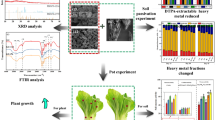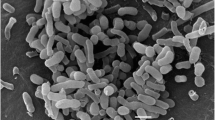Abstract
This work is the first report of the ability of biochar-immobilized cadmium-resistant bacteria (CRB) on promoting the efficiency of cadmium phytoextraction by Chlorophytum laxum R.Br. The survival of CRB immobilized on biochar in cadmium-contaminated soil at a concentration of 75.45 mg kg−1 was studied. The results found that both CRB, namely Arthrobacter sp. TM6 and Micrococcus sp. MU1, can survive and grow in cadmium-contaminated soil. To study phytoextraction in the pot experiments, 2-month-old C. laxum was individually planted in cadmium-contaminated soil and divided into four treatments, including (i) untreated control, (ii) biochar, (iii) biochar-immobilized (BC) Arthrobacter sp., and (iv) BC-Micrococcus sp. The results found that biochar-immobilized CRB did not cause any effect to the root lengths and shoot heights of plants compared to the untreated control. Interestingly, inoculation of biochar-immobilized CRB significantly increased cadmium accumulation in the shoots and roots compared to the untreated control. In addition, the highest cadmium content in a whole plant, best phytoextraction performance, and greatest bioaccumulation factor was found in plant inoculated with BC-Micrococcus sp., followed by BC-Arthrobacter sp. In conclusion, inoculation of biochar-immobilized CRB enhanced cadmium accumulation and translocation of cadmium from the roots to shoots, suggesting further applying biochar-immobilized CRB in cadmium-polluted soil for promoting cadmium phytoextraction efficiency of ornamental plants.

Graphical abstract





Similar content being viewed by others
References
Ab Aziz NS, Mohd Nor MA, Abdul Manaf SF, Hamzah F (2015) Suitability of biochar produced from biomass waste as soil amendment. Procedia Soc Behav Sci 195:2457–2465
Ali H, Khan E, Sajad MA (2013) Phytoremediation of heavy metals: concepts and applications. Chemosphere 91:869–881
Chen B, Yuan M, Qian L (2012) Enhanced bioremediation of PAH-contaminated soil by immobilized bacteria with plant residue and biochar as carriers. J Soil Sediment 12:1350–1359
Chen L, Gao J, Zhu Q, Wang Y, Yang Y (2018a) Accumulation and output of heavy metals by the invasive plant Spartina alterniflora in a coastal salt marsh. Pedosphere 28:884–894
Chen H, Ma J, Wei J, Gong X, Yu X, Guo H, Zhao Y (2018b) Biochar increases plant growth and alters microbial communities via regulating the moisture and temperature of green roof substrates. Sci Tot Environ 635:333–342
Dzionek A, Wojcieszyńska D, Guzik U (2016) Natural carriers in bioremediation: a review. Electron J Biotechnol 23:28–36
Faust MB, Christians NE (2000) Copper reduces shoot growth and root development of creeping bent grass. Crop Sci 40:498–502
Han H, Sheng X, Hu J, He L, Wang Q (2018) Metal-immobilizing Serratia liquefaciens CL-1 and Bacillus thuringiensis X30 increase biomass and reduce heavy metal accumulation of radish under field conditions. Ecotoxicol Environ Saf 161:526–533
He LY, Chen ZJ, Ren GD, Zhang YF, Qian M, Sheng XF (2009) Increased cadmium and lead uptake of a cadmium hyperaccumulator tomato by cadmium-resistant bacteria. Ecotox Environ Saf 72:1343–1348
Hmid A, Al Chami Z, Sillen W, De Vocht A, Vangronsveld J (2015) Olive mill waste biochar: a promising soil amendment for metal immobilization in contaminated soils. Environ Sci Pollut Res 22:1444–1456
Jézéquel K, Perrin J, Lebeau T (2005) Bioaugmentation with a Bacillus sp. to reduce the phytoavailable Cd of an agricultural soil: Comparison of free and immobilized microbial inocula. Chemosphere 59:1323–1331
Jiang LL, Han GM, Lan Y, Liu SN, Gao JP, Yang X, Meng J, Chen WF (2017) Corn cob biochar increases soil culturable bacterial abundance without enhancing their capacities in utilizing carbon sources in Biolog Eco-plates. J Integr Agr 16:713–724
Khaokaew S, Landrot G (2015) A field-scale study of cadmium phytoremediation in a contaminated agricultural soil at Mae Sot district, Tak province, Thailand: (1) Determination of Cd-hyperaccumulating plants. Chemosphere 138:883–887
Khonsue N, Kittisuwan K, Kumsopa A, Tawinteung N, Prapagdee B (2013) Inoculation of soil with cadmium-resistant bacteria enhances cadmium phytoextraction by Vetiveria nemoralis and Ocimum gratissimum. Water Air Soil Pollut 224:1696
Kumar P, Dushenkov V, Motto H, Raskin I (1995) Phytoextraction: the use of plants to remove heavy metals from soils. Environ Sci Technol 29:1232–1238
Li Y, Liu K, Wang Y, Zhou Z, Chen C, Ye P, Yu F (2018) Improvement of cadmium phytoremediation by Centella asiatica L.after soil inoculation with cadmium-resistant Enterobacter sp. FM-1. Chemosphere 202:280–288
Liu X, Zhang A, Ji C, Joseph S, Bian R, Li L, Pan G, Paz-Ferreiro J (2013) Biochar’s effect on crop productivity and the dependence on experimental conditions: a meta-analysis of literature data. Plant Soil 373:583–594
Liu ZF, Ge HG, Li C, Zhao ZP, Song FM, Hu SB (2015) Enhanced phytoextraction of heavy metals from contaminated soil by plant co-cropping associated with PGPR. Water Air Soil Pollut 226:29
Liu Y, Liu K, Li Y, Yang W, Wu F, Zhu P, Zhang J, Chen L, Gao S, Zhang L (2016) Cadmium contamination of soil and crops is affected by intercropping and rotation systems in the lower reaches of the Minjiang river in south-western China. Environ Geochem Health 38:811–820
Liu J, Ding Y, Ma L, Gao G, Wang Y (2017) Combination of biochar and immobilized bacteria in cypermethrin contaminated soil remediation. Int Biodeterior Biodegrad 120:15–20
Lu K, Yang X, Shen J, Robinson B, Huang H, Liu D, Bolan N, Pei J, Wang H (2014) Effect of bamboo and rice straw biochars on the bioavailability of Cd, Cu, Pb and Zn to Sedum plumbizincicola. Agr Ecosyst Environ 191:124–132
Mahar A, Wang P, Ali A, Awasthi MK, Lahori AH, Wang Q, Li R, Zhang Z (2016) Challenges and opportunities in the phytoremediation of heavy metals contaminated soils: a review. Ecotoxicol Environ Saf 126:111–121
Mattina MJI, Lannucci-Berger W, Musante C, White JC (2003) Concurrent plant uptake of heavy metals and persistent organic pollutants from soil. Environ Pollut 124:375–378
McGrath SP, Cunliffe CH (1985) A simplified method for the extraction of the metals Fe, Zn, Cu, Ni, Cd, Pb, Cr, Co and Mn from soils and sewage sludges. J Sci Food Agric 36:794–798
Mitra S, Pramanik K, Sarkar A, Ghosh PK, Soren T, Maiti TK (2018) Bioaccumulation of cadmium by Enterobacter sp. and enhancement of rice seedling growth under cadmium stress. Ecotoxicol Environ Saf 156:183–196
Oliveira FR, Patel AK, Jaisi DP, Adhikari S, Lu H, Khanal SK (2017) Environmental application of biochar: Current status and perspectives. Bioresour Technol 246:110–122
Pramanik K, Mitra S, Sarkar A, Maiti TK (2018) Alleviation of phytotoxic effects of cadmium on rice seedlings by cadmium resistant PGPR strain Enterobacter aerogenes MCC 3092. J Hazard Mater 351:317–329
Prapagdee B, Wankumpha J (2017) Phytoremediation of cadmium-polluted soil by Chlorophytum laxum combined with chitosan-immobilized cadmium-resistant bacteria. Environ Sci Pollut Res 24:19249–19258
Prapagdee B, Chumphonwong N, Khonsue N, Mongkolsuk S (2012) Influence of cadmium resistant bacteria on promoting plant root elongation and increasing cadmium mobilization in contaminated soil. Fresen Environ Bull 21:1186–1191
Prapagdee B, Chanprasert M, Mongkolsuk S (2013) Bioaugmentation with cadmium-resistant plant growth-promoting rhizobacteria to assist cadmium phytoextraction by Helianthus annuus. Chemosphere 92:659–666
Prapagdee S, Piyatiratitivorakul S, Petsom A, Tawinteung N (2014) Application of biochar for enhancing cadmium and zinc phytostabilization in Vigna radiata L. cultivation. Water Air Soil Pollut 225:2233
Rajkumar M, Ael N, Narasimha M, Prasad MNV, Freitas H (2010) Potential of siderophore-producing bacteria for improving heavy metal phytoextraction. Trends Biotechnol 28:142–149
Rizwan M, Ali S, Qayyum MF, Ok YS, Zia-ur-Rehman M, Abbas Z, Hannan F (2017) Use of maize (Zea mays L.) for phytomanagement of Cd-contaminated soils: a critical review. Environ Geochem Health 39:259–277
Rojjanateeranaj P, Sangthong C, Prapagdee B (2017) Enhanced cadmium phytoremediation of Glycine max L. through bioaugmentation of cadmium-resistant bacteria assisted by biostimulation. Chemosphere 185:764–771
Shute T, Macfie SM (2006) Cadmium and zinc accumulation in soybean: a threat to food safety? Sci Total Environ 371:63–73
Simmons RW, Pongsakul P, Chaney L, Saiyasitpanich D, Klinphoklap S, Nobuntou W (2003) The relative exclusion of zinc and iron from rice grain in relation to rice grain cadmium as compared to soybean: implications for human health. Plant Soil 257:163–170
Siripan O, Thamchaipenet A, Surat W (2018) Enhancement of the efficiency of Cd phytoextraction using bacterial endophytes isolated from Chromolaena odorata, a Cd hyperaccumulator. Int J Phytoremediat 20:1096–1105
Taiwo AM, Gbadebo AM, Oyedepo JA, Ojekunle ZO, Alo OM, Oyeniran AA, Onalaja OJ, Ogunjimi D, Taiwo OT (2016) Bioremediation of industrially contaminated soil using compost and plant technology. J Hazard Mater 304:166–172
Wang Y, Yan A, Dai J, Wang N, Wu D (2012) Accumulation and tolerance characteristics of cadmium in Chlorophytum comosum: a popular ornamental plant and potential Cd hyperaccumulator. Environ Monit Assess 184:929–937
Wiangkham N, Prapagdee B (2018) Potential of Napier grass with cadmium-resistant bacterial inoculation on cadmium phytoremediation and its possibility to use as biomass fuel. Chemosphere 201:511–518
Xia HP (2004) Ecological rehabilitation and phytoremediation with four grasses in oil shale mined land. Chemosphere 54:345–353
Yang X, Chen A, Wu Q, Xu M (2018) Enhanced phenanthrene degradation in river sediments using a combination of biochar and nitrate. Sci Total Environ 619–620:600–605
Yavari S, Malakahmad A, Sapari NB (2015) Biochar efficiency in pesticides sorption as a function of production variables: a review. Environ Sci Pollut Res 22:13824–13841
Yoon J, Cao X, Zhou Q, Ma LQ (2006) Accumulation of Pb, Cu, and Zn in native plants growing on a contaminated Florida site. Sci Total Environ 368:456–464
Zhang X, Xia H, Li Z, Zhuang P, Gao B (2010) Potential of four forage grasses in remediation of Cd and Zn contaminated soils. Bioresour Technol 101:2063–2066
Zhang C, Sale PWG, Doronila AI, Clark GJ, Livesay C, Tang C (2014) Australian native plant species Carpobrotus rossii (Haw.) Schwantes shows the potential of cadmium phytoremediation. Environ Sci Pollut Res 21:9843–9851
Acknowledgements
The authors thank V. Vanitshavit, A. Nisaitrongsrisug, and N. Siribanchachai for their valuable technical assistances. Appreciation is also expressed to Dr. T.N. Stewart for proofreading this article.
Funding
This research was supported by a grant from the Center of Excellence on Biodiversity (grant number BDC-PG1-160003) and the Faculty of Environment and Resource Studies of Mahidol University Alumni Association.
Author information
Authors and Affiliations
Corresponding author
Ethics declarations
Conflict of interest
The authors declare that they have no conflict of interest.
Additional information
Responsible editor: Elena Maestri
Publisher’s note
Springer Nature remains neutral with regard to jurisdictional claims in published maps and institutional affiliations.
Rights and permissions
About this article
Cite this article
Chuaphasuk, C., Prapagdee, B. Effects of biochar-immobilized bacteria on phytoremediation of cadmium-polluted soil. Environ Sci Pollut Res 26, 23679–23688 (2019). https://doi.org/10.1007/s11356-019-05661-6
Received:
Accepted:
Published:
Issue Date:
DOI: https://doi.org/10.1007/s11356-019-05661-6




